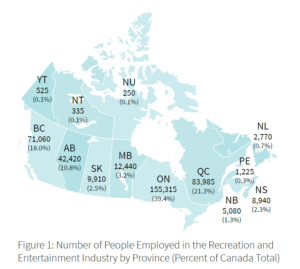 Tourism HR Canada has released a second set of updated demographic summaries, examining the workforce in the recreation and entertainment, transportation, and travel services industries. These cover businesses ranging from heritage institutions to gambling places, from airlines to tour operators, and travel arrangement and reservations services.
Tourism HR Canada has released a second set of updated demographic summaries, examining the workforce in the recreation and entertainment, transportation, and travel services industries. These cover businesses ranging from heritage institutions to gambling places, from airlines to tour operators, and travel arrangement and reservations services.
Based on the most recent Canadian census data (2016), these summaries show how many individuals are working in each industry across the country, and analyze such characteristics as age, gender, immigrant status, and education. The summaries also explore the occupations that employ the largest number of people and whether they are employed full- or part-time, year-round or seasonally.
Additionally, the summaries describe industry workforce trends since the 2011 census. Many industry groups saw a rise in total employment numbers, but some, like travel services, saw jobs decrease. Reflecting Canada’s labour force as a whole, the average worker age increased, as did the percentage of immigrant and non-permanent resident workers.
Other highlights include:
- Some recreation and entertainment occupations had a strong gender divide. Over 75% of outdoor sport and recreation guides, janitors/caretakers, and landscapers identified as male, while more than 70% of accounting clerks and human resource managers were female.
- Over 30% of the transportation workforce is over the age of 55, making it the highest in the tourism sector, and about 10% higher than the national average. This suggests significant labour shortages are imminent.
- Travel services had more employees who had immigrated to Canada than any other tourism industry group, at 35.2%.
- Small businesses are common: 80.4% of transportation businesses had fewer than 20 employees, as did 91% of travel services.
These profiles offer tourism stakeholders from employers to policy makers a detailed look at one of Canada’s fastest-growing economic sectors, offering insights into creating targeted attraction and retention efforts, progressive HR practices, and innovative education and training solutions.
Access these and other summaries from our Labour Market Information section.

